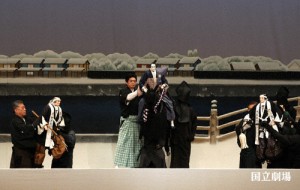Bunraku “Kanadehon Chuushinngura” 2016 12/9
Last evening, I went to National Theater to watch Bunnraku which is one of Japanese traditional theater arts and is composed of three parts, namely puppet play, musical narration and shamisen( three stringed Japanese style banjo).
Last evening’s program was “Kanadehon Chuushinngura” which is one of the most popular programs even though it was written more than 260 years ago. The story is based on the real famous revenge happened in 1703 in Edo.
Revenge was legally approved in Japan until Meiji reformation. When anyone of the family was killed by others by any reason, it was a duty and right for the family left to take revenge.
The said incident was the fight between two lords regarding the ritual at Edo castle.
One attacked the other in the sacred corridor where any fight was severely forbidden.
Attacker, the lord of Ako feudal was sentenced to be killed by himself in samurai’s special way, while the other, the lord of Kira feudal recovered from the injury and was spending formal life as before.
Feudal samurais in Ako were entirely unsatisfied with the judge and were waiting for the opportunity to take revenge against the other lord. Kira feudal protected the lord carefully and Ako samurais spent almost three years in vain and finally in the night of snowfall,47 loyal Samurais raid in the mansion of Kira feudal and took the neck of the lord successfully.
After the long and difficult arguments among Tokugawa government, in spite of their superb royal performance, they were forced to be killed by themselves in Samurai’s special way. It was the judge to show people the importance of keeping laws, however majority of people regretted the judge and applauded the Ako samurai’s performance passionately.
“Kanadehon Chuushinngura”was written based on this revenge and revealed not only samurai’s efforts and agony but also their family’s understanding, support and agony.
The program was composed of 11 acts and took 10 hours. I watched latter half of the play. Most acts were about the quiet deep agony and dignified pride of Ako samurai’s wives and daughters.
Today’s top artists of Bunraku gathered and played. Three parts, namely puppet, musical narration and shamisenn were harmonized perfectly and moved fully packed audiences.








